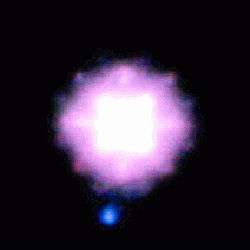SCR 1845-6357
 Three-colour image of SCR1845-6357AB generated from the SDI filter images (blue=1.575 micrometre, green=1.600 micrometre, red=1.625 micrometre). Because the T-dwarf fades away towards the longer wavelengths, it appears quite blue in this image. It is roughly 50 times fainter than the star and is separated from it by an angle of 1.17 arcsecond on the sky (4.5 times the Earth-Sun distance). | |
| Observation data Epoch J2000.0 Equinox J2000.0 (ICRS) | |
|---|---|
| Constellation | Pavo |
| Right ascension | 18h 45m 05.26s[1] |
| Declination | −63° 57′ 47.8″[1] |
| Apparent magnitude (V) | 17.4[2] |
| Characteristics | |
| Spectral type | M8.5[3] |
| Astrometry | |
| Proper motion (μ) | RA: 2444[2] mas/yr Dec.: 696[2] mas/yr |
| Parallax (π) | 259.45 ± 1.11[1] mas |
| Distance | 12.57 ± 0.05 ly (3.85 ± 0.02 pc) |
| Details | |
| Mass | 0.07 [4] M☉ |
| Radius | 0.096 R☉ |
| Luminosity | 0.0004 L☉ |
| Temperature | 2600–2700[3] K |
| Other designations | |
| Database references | |
| SIMBAD | The system |
| A | |
SCR 1845-6357 is a binary system, about 12.6 light-years away in the constellation Pavo. The primary is a faint red dwarf. It has a brown dwarf companion.
SCR 1845-6357 A
The primary, SCR 1845-6357A, is a faint (apparent magnitude 17.4)[2] red dwarf with a mass of about 7% of the Sun's. However, the measurements are still preliminary and are subject to change.[4]
SCR 1845-6357 B
| Position (relative to A) | |
|---|---|
| Epoch of observation | J2006.3 |
| Angular distance | 1.064 ± 0.004″ [3] |
| Position angle | 177.2 ± 0.06° [3] |
| Observed separation (projected) | 4.10 ± 0.04 AU [5] |
| Characteristics | |
| Spectral type | T6 [3] |
| Apparent magnitude (J) | 13.26[6] |
| Details | |
| Mass | 0.04 to 0.05 [3] M☉ |
| Surface gravity (log g) | 5.1 [3] cgs |
| Temperature | 950 [3] K |
| Age | 1.8·109 to 3.1·109 [3] years |
| Other designations | |
| Database references | |
| SIMBAD | B |
.svg.png)
This star has been found to possess a brown dwarf companion, designated SCR 1845-6357B. The companion, classified as a T-dwarf, has an observed projected distance of 4.1 AU, an estimated mass between 40 and 50 times the mass of Jupiter, and an estimated effective temperature of 950 K.[3][5] The brown dwarf has a near-IR J-band magnitude of 13.26.[6]
References
- 1 2 3 Henry, T. J.; Jao, Wei-Chun; Subasavage, John P.; Beaulieu, Thomas D.; Ianna, Philip A.; Costa, Edgardo; Méndez, René A. (2006). "The Solar Neighborhood. XVII. Parallax Results from the CTIOPI 0.9 m Program: 20 New Members of the RECONS 10 Parsec Sample". The Astronomical Journal. 132 (6): 2360–2371. arXiv:astro-ph/0608230
 . Bibcode:2006AJ....132.2360H. doi:10.1086/508233.
. Bibcode:2006AJ....132.2360H. doi:10.1086/508233. - 1 2 3 4 5 DENIS-P J184504.9-635747, entry, SIMBAD. Accessed on line June 17, 2008.
- 1 2 3 4 5 6 7 8 9 10 11 12 The very nearby M/T dwarf binary SCR 1845-6357, Markus Kasper, Beth A. Biller, Adam Burrows, Wolfgang Brandner, Jano Budaj, and Laird M. Close, Astronomy and Astrophysics 471, #2 (August 2007), pp.655–659. Bibcode: 2007A&A...471..655K. doi:10.1051/0004-6361:20077881.
- 1 2 Research Consortium On Nearby Stars, Georgia State University (January 1, 2008). "THE ONE HUNDRED NEAREST STAR SYSTEMS". RECONS. Retrieved June 17, 2008. External link in
|journal=(help) - 1 2 Observed projected distance computed from parallax and observed angular distance.
- 1 2 Chris Gelino, Davy Kirkpatrick, Adam Burgasser. "DwarfArchives.org: Photometry, spectroscopy, and astrometry of M, L, and T dwarfs". caltech.edu. Retrieved 2012-06-10. (main page)
- ↑ SCR J1845-6357B, entry, SIMBAD. Accessed on line June 17, 2008.
- Hambly, Nigel C.; Henry, Todd J.; Subasavage, John P.; Brown, Misty A.; Jao, Wei-Chun (2004). "The Solar Neighborhood. VIII. Discovery of New High Proper Motion Nearby Stars Using the SuperCOSMOS Sky Survey". The Astronomical Journal. 128 (1): 437–447. arXiv:astro-ph/0404265
 . Bibcode:2004AJ....128..437H. doi:10.1086/421748.
. Bibcode:2004AJ....128..437H. doi:10.1086/421748. - B.A. Biller et al., 2006, "Discovery of a Brown Dwarf Very Close to the Sun: A Methane-rich Brown Dwarf Companion to the Low-Mass Star SCR 1845-6357", Astrophysical Journal Letters.
Notes
-
.jpg)
Artist's impression of the SCR 1845-6357 stellar system.
External links
- New Objects within 20 light-years at SolStation.
- SCR 1845-6357